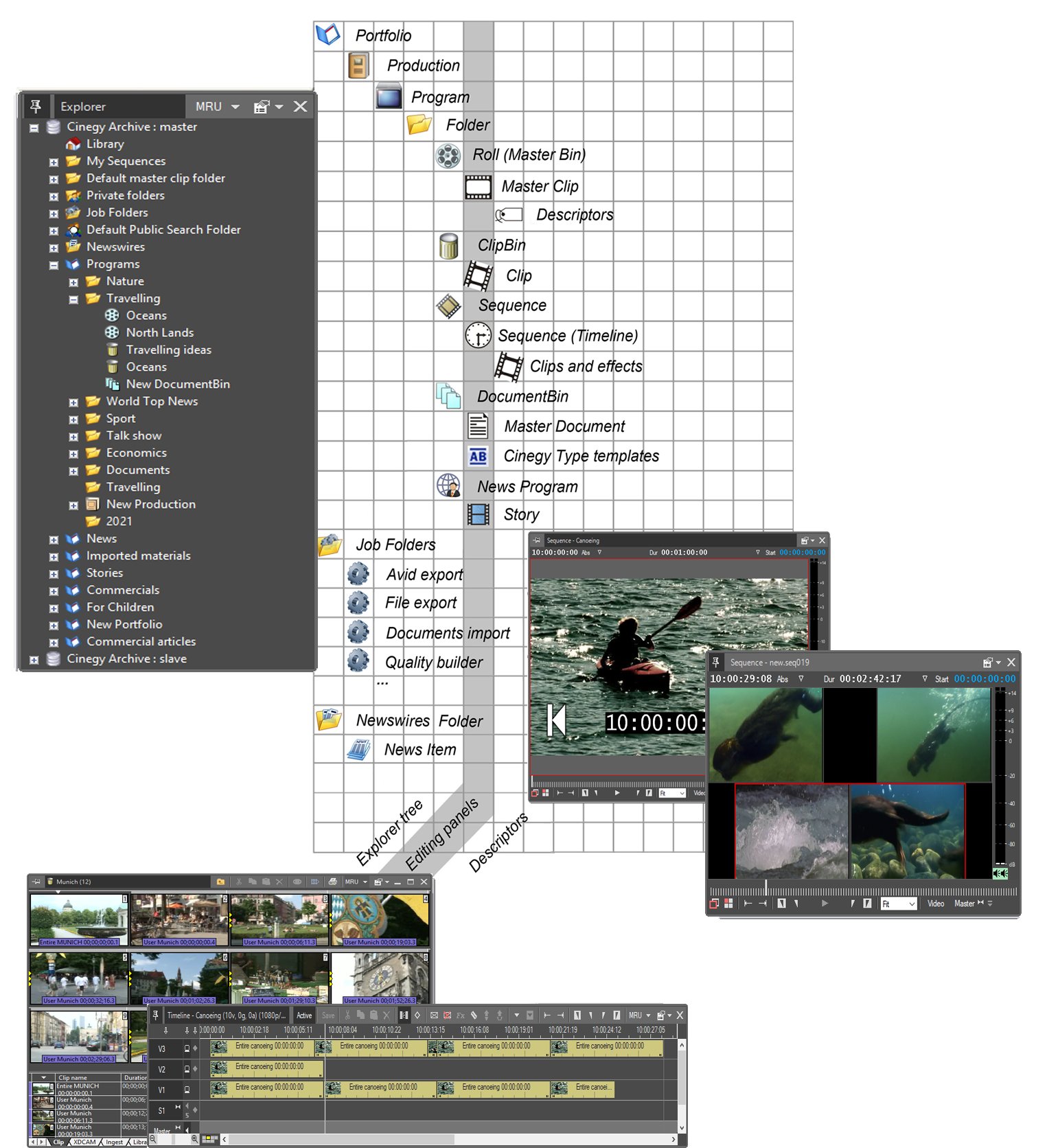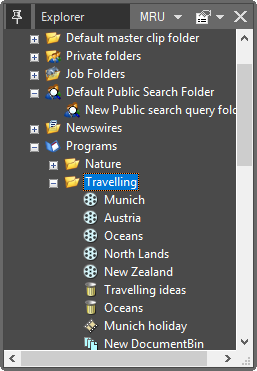Visual Hierarchy
Reading time ~6 minutes
The illustration below represents the visual hierarchy of the elements in Cinegy Desktop.
There are several levels of objects, which are shown in the explorer window; these are different folders and Sequences.
|
Important
|
You can assign access rights to any object via Cinegy Archive Manager. Refer to the Nodes Explorer article in the Cinegy Archive Manager Manual for details. |
To give more details, a Cinegy Desktop client opens the item in a dedicated editor window. For example, the bins and Rolls will be shown in the bin window, and the Sequences on Timeline.
Even more details can be shown with additional interface elements. For example, to explore a clip in a ClipBin, Clip Viewer is launched.

Tree Structure
The entire content of Cinegy Archive is represented for the user as a tree of different folders, containing various terminal objects:

The entire database structure is stored on the Cinegy Archive server.
Folders
The folders in Cinegy Archive are the containers for different terminal objects and other folders, rather similar to a typical directory structure in Windows.
Standard Folder
|
This folder type is always present in the system. It can contain other folders and objects. |
Search Folders
The search folder is a special folder type assigned to store the search queries. There are two types of search folders:
|
A public search query folder can be created within the Default Public Search Folder. Public search folders store public search queries visible to all users. |
|
A private search query folder can be created individually for each user within the private folders root. Private search folders store private queries visible to the owner user only. |
|
Important
|
Refer to the Search Queries article to learn more about search folders and their management. |
Cinegy Convert Job Folder
|
A Cinegy Convert job folder is a special folder type. Dedicated functions are predefined to enable automatic processing of different job types. |
|
Important
|
Refer to the Cinegy Convert documentation for detailed information about creation, maintenance and use of Cinegy Convert job folders. |
Newswires
|
The Newswires is a special folder containing the news items grabbed via Cinegy Newswire Service from various news providers and then published in Cinegy Archive. |
|
Important
|
Refer to the Cinegy Newswire section to learn about the news service. |
Portfolios
|
The Portfolio is the top-level folder. |
User-Defined Folders
Your system can be customized by your system administrator to hold additional types of folders, to suit the needs of your production house. The most typical example would be "Production" or "Program" or "Trailer". Typically, the hierarchy in Cinegy Archive starts with Production folders.
The standard Cinegy Archive comes pre-configured with the following folders:
|
A Production folder is a high-level folder; it can only be created in a Portfolio. Usually it contains a set of Program folders. |
|
A Program folder is usually located inside a Production folder, and is intended to hold assets related to one TV program. |
The business rules defining which types of folders can reside inside any given folder type are also set up by your administrator. When creating a new folder, Cinegy Desktop always shows you only the permitted set of folder types in the menu.
|
Important
|
Refer to the Node Types article in the Cinegy Archive Manager Manual to learn how to create new folder types. |
Terminal Objects
These are the objects in the tree which cannot contain further items. When activated, they are opened in a dedicated editor window in Cinegy Desktop. For example, opening a bin object launches the bin window, and opening a Sequence object launches Timeline.
Roll
|
A Roll is a container for master clips. The Roll normally represents one capture/import session, i.e. a tape, a file or a piece of live ingest. Double-clicking the icon opens the master bin window. The bin may contain one or more entire master clips marked with a blue frame and several master clips (subclips) obtained in the result of splitting or editing the entire master clip. The number of entire master clips depends on the number of clips detected during the ingest process. |
|
Important
|
Refer to the Working with Master Clips paragraph for more information about operations with Master Clips. |
|
Important
|
Refer to the Setting Up Capture Session paragraph for more information about Roll creation and capture sessions. |
Placeholder MOG
|
A placeholder MOG is a special type of Roll with a predefined TV format, start timecode and duration. It is used as a temporary substitution for source essence that has not yet been captured/imported. You can assign a placeholder MOG as the target for capture/import. In this case, the placeholder MOG will be converted to the Roll and all references to its essence will be updated. |
|
Important
|
Refer to the Placeholder MOGs article for details about working with the placeholder Rolls. |
ClipBin
|
A ClipBin is a container for user clips, or simply clips. It allows you to browse, collect, preview and rough cut your material. Double-clicking the icon opens the ClipBin window. |
|
Important
|
Refer to the Working with Bins section to learn more about working with ClipBins. |
Sequence
|
A Sequence is a project on Timeline. It can contain multiple clips with various effects, audio tracks with volume control, etc. When double-clicked, it will be opened in the Timeline window. |
|
Important
|
Refer to the Timeline section to learn more about working with Sequences. |
DocumentBin
|
The DocumentBin contains documents (files) imported into Cinegy Desktop. It provides a flexible check-in and check-out mechanism, and keeps all the previous versions of the imported documents. |
|
Important
|
Refer to the Working With DocumentBin article for details. |
News Item
|
A news item is an automatically created read-only object for a specific date, registered in Cinegy Archive and stored in the Newswires folder. Double-clicking the news item opens the Newswire Browser with the list of imported news content in it. Each news element there includes a news headline, full or short text, and metadata such as publication date, news agency and copyright notice, and a link to the source (e.g. an html page), as well as links to media materials as an option. |
Story
|
A Story is a project for the Cinegy Studio application. It can contain multiple clips, Sequences, graphics objects, placeholders and written scripts. When double-clicked, it will be opened in the Story Editor window. |
|
Important
|
Refer to the Working With Stories section for details. |
|
Important
|
To learn about Cinegy Studio, refer to the Cinegy Studio Manual. |
News Program
|
A News Program is a container for news Stories. It allows you to create, browse, collect, preview and final cut your Stories as well as create Rundowns and templates for each day of week separately. Double-clicking the icon opens the News Program Manager window. |
|
Important
|
Refer to the News Program Manager section to learn more about working with News Programs. |
Library and Library Folders
|
The Library is the special entry in the root of the tree. It is used to store the corporate materials, for example, corporate logo or countdowns. In addition, it may contain the published materials that are permitted to be used within your organization without any need to consult with the legal department. |
|
Normally, the Library is configured to contain only the Library folders. The Library folders in their part can be configured to contain only the objects defined by the business rules in your organization. |









